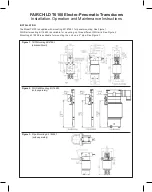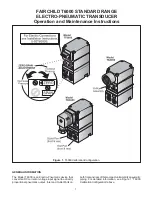
Cable termination for panel-mounted instrument CPM 332 with screwed BNC connector
1. Cut off wire end sleeves of the coaxial
cable.
2. Insert cable gland (
➀
) and washer (
➁
) on
cable, remove inner insulation (13 mm), then
screw clamping ring (
➂
) onto insulation.
Please note: Parts
➀
to
➂
are supplied for
cable diameters of 3.2 mm and 5 mm.
3. Fold braided screen (
➃
) of screen back
over clamping ring and cut off excess
material.
4. Strip the black semiconductor layer to the
screen (reference signal).
5. Remove inner insulation (4 mm).
Use the supplied end sleeves (
⑨
) for the
stranded inner conductor. When using a
cable of another manufacturer use the end
sleeves only in case of single stranded
conductors.
6. Push BNC connector shell (
➄
) over the
cable (inner conductor must be located in
clamping notch (
➅
) in the connector pin).
Tighten cable gland (
➀
).
Clamp the inner conductor in the notch by
inserting the clamping piece (
➆
) and
screwing on the cover (
➇
), thereby
establishing proper contact.
Connection examples
Choice: symmetrical or asymmetrical?
The pH and redox electrodes can be
connected in either a symmetrical or an
asymmetrical configuration. General rule:
• Potential matching connection does not
exist – asymmetrical connection
(Figs. 3.18 and 3.19).
• Potential matching connection exists –
symmetrical connection
(Figs. 3.18 and 3.19).
However, which arrangement to use may also
depend on operating conditions.
CPK1.CDR
Outer
insulation
Outer screen
(to PE)
Inner screen
(ref.)
Coax
(pH / mV)
Litz wire bn
Fig. 3.14
Cable CPK 1:
Instrument connection
semiconductor layer
KABEL.CDR
Fig. 3.15
Coaxial cable construction
13
16
4
➁
➀
➂
➃
BNC1NEU.CDR
⑨
Fig. 3.16
Termination of
pH connecting line
for installation of BNC
elbow plug
➄
➀
➆
➅
➇
BNC2NEU.CDR
Fig. 3.17
Installation of terminated
pH connecting line
in BNC elbow plug
PM253E03.CHP
Liquisys M CPM 223 / 253
Installation
Hauser
15
















































